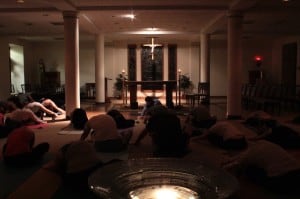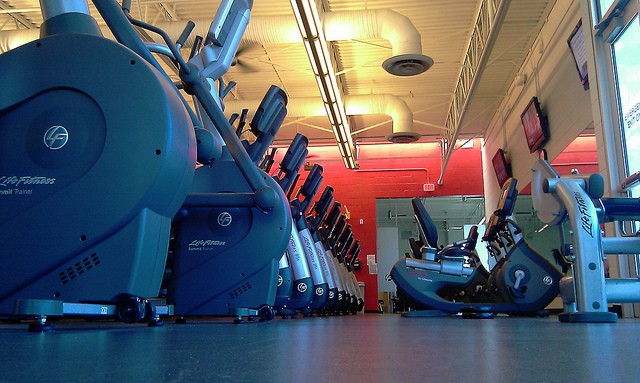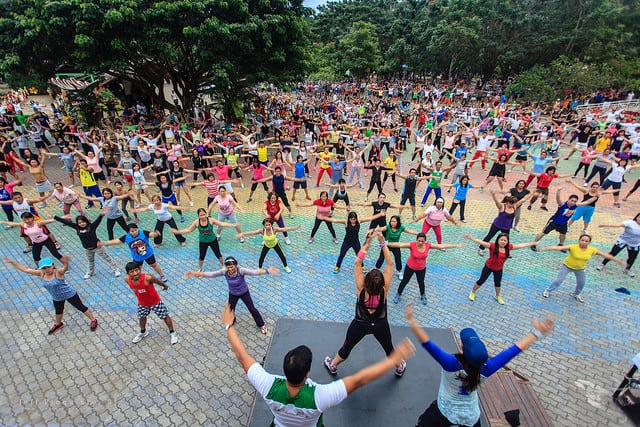What happened to the gym? It used to be the popular place for workouts and exercise. The combination of cardio equipment and weights served people of a variety of backgrounds and fitness levels. It filled up in early January with people trying to start the new year right with resolutions to get healthy and fit. There were pre-dawn crowds and post-work crowds treadmilling in state-of-the-art Cardio Theaters, while weightlifters admired their muscles from all angles with the wall of mirrors.
What happened to those days? When I poll my friends and peers, a declining number are making regular visits to this remnant of a fading era of fitness. The gym is trending down.
So where are people going? You probably already know the answer, because you are probably one of the masses that subscribes to the health and fitness benefits of CrossFit, or Orange Theory, or November Project. Perhaps you’re part of the growing legion of yogis or Zumba enthusiasts. Have you thrown in the towel on 5K runs and converted to Tough Mudders? Did you trade American Idol for America Ninja Warrior??
These alternative forms of workout and fitness have exploded in popularity over the past decade. Don’t believe me? Take CrossFit for example. The first CrossFit gym opened in 2001. By 2005 there were 13 affiliate gyms, but today (less than 10 years later) there are 10,000. It took McDonald’s (you may have heard of it) 33 years to reach 10,000 restaurants.1
*****
Why have these programs grown so popular? What do they offer that you don’t get at a regular gym? I have to think that it’s more than just a healthy workout. There’s got to be something deeper going on here.
So I have been checking them out recently, under the guidance of my health-crazed sister and a few other fitness-inclined friends. I have taken a stab at a handful of CrossFit WODs (workouts of the day), tracked my heart rate through a grueling 60 minutes of Orange Theory, and woken up before 6am to join the November Project for some free, outdoor fitness. I have even bended, folded, buckled and crumbled through a variety of yoga practices.
All of these experiences have been challenging and enriching. They have provided satisfying physical workouts – sometimes exhausting, sometimes exhilarating. But more than that – the workouts have helped to clear my head, boost my spirits, and make me feel part of something bigger than myself. There is something deeper going on here: people can’t be joining these programs solely for physical fitness. I have found an increasing number of my peers trying to meet their personal needs (and I would argue, spiritual needs as well) in these fitness programs.
We have all heard the tagline “spiritual, but not religious.” We all know about the well-documented growth in the religiously “unaffiliated,” and a growing number of Americans are identifying their religion as “nothing in particular.” This movement is not an unfamiliar topic to TJP.
Perhaps in some of the marbled halls of Vatican City this religious malaise can be cast pessimistically as fading membership. But it can also be an optimistic, even exciting prospect of a populace of seekers. I mean, people still have needs, right? They’re still longing for something, right? People are looking for ways to connect to something beyond themselves, to be fed and nourished in a deeper sense.
Between conversations, TABATAs, AMRAPs, and hours of other sweaty, spandex-wearing research, what I’ve found is that these so-called post-religious friends and peers of mine are actually not all that different from me: the reasons they are seeking alternative fitness programs are actually the same reasons that keep me going to church. So what follows is a list of 5 of those reasons.
1- Personal Development
Okay, let’s start with the most obvious one. People get involved in these fitness programs to improve their health – an important component of personal development. Each program offers different benefits to your health, but that’s just the starting point. If you like sweating and toning your muscles, you might join CrossFit or Orange Theory. If you need some fun tunes to keep you moving, you’ll find a better fit with Zumba. If you are looking for total body fitness while centering yourself, go ahead and order a yoga mat from Amazon.
Not only do these fitness programs focus on physical health, but they also contain an element of general self-improvement. They are not about merely maintaining your lifestyle and fitness level- they are about improving. Even the most fit participants are looking to press and challenge themselves.
A desire for personal development and health (certainly in the sense of spiritual health) are big motivations for my active faith life. I’m not looking just to maintain some base level of faith practice: there is room for spiritual growth and improvement. There are always ways for me to grow in love and faith and to encounter my faults and failings.
2- Ritual
Ritual tends to get a bad rap. It’s practically treated like a bad word. When we think of ritual, it conjures up a host of negative images and impressions. It’s associated with magic and superstition. But we need to de-mystify ritual, because it’s a regular part of our lives.
How do you spend the first thirty minutes of your day? Or the last thirty? What are the things you do to prep for when guests are arriving? How do you spend the holidays? These events make up the rituals of our daily life. It’s impossible to avoid the prevalence of ritual in our culture. Sunday Mass might have been replaced by Sunday football in many American households, but both events are rich in ritual.
Unlike gym trips of old, these fitness programs like to offer something unique in their programming – their own form of ritual. They always operate within a given philosophy, whether it is the accelerated heart-rate of Orange Theory or the Latin music-infused Zumba. So in a sense, you know what you’re getting into (you know the philosophy of the ritual), without getting bored with repetition.

Chapel Yoga at Fordham University
Photo courtesy of Bobby Karle, SJ, Ken Homan, SJ and Fordham University Campus Ministry
Who wants “boring” to describe their workouts? This can be a danger of workouts at the gym, which can end up too monotonous and static. These new fitness programs throw that kind of routine out the window. Working within various confines, they focus on keeping things fresh and different. Every day is a different workout.
As a regular churchgoer, the Mass is the ritual which forms my faith life. Despite the many repetitive elements of the Mass, there can be wide variety within its structure, from the rotating readings, to different homilies, music, and changing prayers and petitions. With openness and attentiveness, Mass can be a rich and rewarding ritual. Admittedly, it doesn’t always come off this way. Readings can be confusing and homilies can be (dare I say it?) boring. But let’s not throw out the wine with the cork. There remains a depth and importance to the ritual itself and the giving of thanks.
3- Accountability
These new fitness programs are all about getting you to come…and to stay. It’s about investment and accountability. In some cases, this is a question of financial commitments and how that investment leads to accountability.
Plenty of yoga studios offer a free trial period, but once you commit, you’re paying to go, so you better show up. CrossFit locations typically offer a free Saturday morning class, but everything else is going to cost you. Even as a paying customer, you can’t show up to do your own workout at whatever time you please. If that’s what you want, go back to the dusty old gym. Consider these costs an investment in your health and fitness.
When you have buy-in, that brings a level of accountability. Some of these fitness programs are even using social media for greater accountability. November Project, which doesn’t require a financial investment, keeps people accountable with online “verbals,” which are commitments to attended a workout. People who don’t show are then featured on their “We Missed You” section. Nothing like a little social-media peer pressure to get you out of bed and working out!
When it comes to investing in the church and our faith, I’m not talking about the collection basket. Investment comes from the personal commitment to get involved and share your gifts (financial or otherwise) with the parish community. What’s surprising, is even though there thankfully isn’t a Facebook page with weekly Mass attendance, when I’m not there, people miss me. That kind of accountability comes from both peers and mentors. The question moves from “what do I get out of Mass” to “What am I putting into it?”
4- Discipline
The weak and lazy need not apply. Please return to the gym, or more appropriately, the couch. These new fitness trends are not for the faint of heart, even if they offer workouts that are customizable to different fitness levels.
Orange Theory straps on a heart-rate monitor before your workout. The goal is to get your heart rate high for a portion of your workout (into the “orange zone”), which not only burns calories during the workout, but also boosts your metabolism a full day beyond. That’s right- your body is still working out after you’re done! Sounds great, right? It might sound good if you’re reading this article on an iPad at a coffee shop, but when you have to keep bumping up the treadmill speed while panting for breath, it’s a matter of discipline. Do you have it in you??
The kind of discipline that these fitness programs require and draw out of us make something like fasting from meat on Fridays in Lent seem like a day at the beach. The Catholic faith, as well as many other religious traditions ask for rigorous discipline. Fortunately, it’s not all giving up and sacrifice. There are also positive disciplines of making time on a regular basis for prayer or meditation.
5- Community
Forget about going to the gym alone: these popular fitness programs are all about group participation. And this might be the most important part. They bring people together and emphasize a spirit of community. All of the fitness programs mentioned involve workouts done in groups, from Yoga sessions to CrossFit WODs. At a Tough Mudder, people hang out at obstacles to help other people get through them, or even just to cheer them on. Our own TJP author and power-lifting extraordinaire, Ken Homan, recently highlighted the importance of exercising community.
Just like these fitness programs, community is fundamental to Church. It’s about bringing people together and building bridges across ages and backgrounds. Church is where I find community: not an easy, we-all-think-alike type of community, but one that challenges me to love in profound and difficult ways. James Joyce said of the Catholic Church, “Here comes everybody.” Unlike our Facebook newsfeed, Instagram accounts, and Twitter feeds, we don’t get to curate our community at Church.
*****
People might be leaving the gym, but health and fitness programs are growing by leaps and bounds. It’s likely that you don’t even need reasons to avoid the gym – you’ve already found something that works better for you.
What do you find where you go? It can’t just be a better way to get in shape. Personal development? Ritual? Accountability? Discipline? Community?
So many of us are seekers, rich in spiritual-drives, looking to be filled. We are pursuing the human needs that drive us all. Greater numbers are finding these needs better fulfilled outside of the Church in a variety of places: on a yoga mat or in a Zumba studio. The myth is that these two activities are mutually exclusive. They’re not. My faith and my physical fitness inform and complement each other. The Church can learn a lot and grow by finding ways to reach out to today’s generation of seekers. To help make a people more than just CrossFit, but fit for the cross.
— — — — —
- All of these new workout practices have faced criticism and scrutiny. They bring change from the normal order: the gym doesn’t want to be empty. Others question whether a program like CrossFit exposes participants to excessive injuries. But regardless of their merits or costs, there is no denying that people are gravitating to these programs by busloads. ↩




